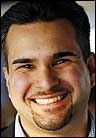When British reality TV program Celebrity Big Brother—which chronicles the activities of 11 celebrities living together in the same house—launched its new season this year, it took advantage of a new tool to mine data and entertain the public: radio frequency identification. With RFID technology, the show’s creator, a company known as Endemol, can provide viewers with additional details regarding the celebrity participants, which include singer LaToya Jackson, rapper Coolio and British weather forecaster Ulrika Jonsson.
Each celebrity appearing on Celebrity Big Brother wears a battery-powered RFID tag. With reads captured from interrogators deployed throughout the Big Brother house, the show’s producers can gather and analyze data regarding where, and with whom, participants spend their time, with graphs and diagrams supporting the results. “It adds a geeky fact file on things,” says Gareth Collett, the series’ executive producer. The system was provided by RFID technology supplier Wavetrend.

When the show began its 2009 season following a year-long hiatus, Collett says, the producers sought a new method for providing viewers with more detail and entertainment. They came upon the idea of RFID technology, and approached Wavetrend in November 2008. Wavetrend had provided people-monitoring data for previous television programs in the United Kingdom, but is better known for its applications for tracking computer servers or other IT equipment.
Wavetrend had three weeks to design and install the RFID system in the show’s approximately 10-room house, explains the company’s CEO, Saleem Miyan. The system was installed by Dec. 15, 2008, when producers began a pilot program for the new series, and went live on Jan. 4, 2009, when the program first aired to an audience of 6 million viewers.
To provide a system that can display and track the locations of participants 24 hours a day for the duration of the three-week program, Wavetrend installed 15 interrogators throughout the house. The company mounted several readers on the ceiling in one large room, as well as on rooftops, in order to pinpoint a celebrity’s location outside, in the garden. The program provides each cast member with a wireless microphone that can be worn around the neck, or attached to a belt. Wavetrend embedded one of its RFID tags in each wireless mike. Each tag’s RFID chip transmits a unique number identifying its wearer.
The tags transmit constantly to Wavetrend interrogators, which capture each tag’s signal and send its unique ID number via an Ethernet connection to an Ethernet hub, then on to a server. Wavetrend’s AssetTrace software collects and translates data, determining the tag’s location within a meter, based on signal strength as measured by the reader. The AssetTrace system enables the show’s producers to display a map of the house with a color-coded dot indicating each participant’s location in real time, which they can view on their own monitors. In the future, this information could be made available online.
The software also allows producers to analyze location data, to determine such things as how long a particular participant spends in any one location—such as in bed, or in the garden—and when, as well as the length of time one participant spends with another.
On the televised show, which airs daily, the producers disseminate the location data in a limited fashion. But on the Internet, Miyan says, the software could enable fans to view each participant’s location in real time, though Celebrity Big Brother does not yet provide that service to its viewers.
“We’re just getting through the teething process,” Collett explains.
Collett says he expects the technology to add an additional level of detail that producers could not realistically provide to viewers solely by means of the house’s 35 cameras. “In theory,” he says, “we could get this information from the cameras if we sat there watching everything with a stop clock in hand. But with this system, that isn’t necessary.”
Thus far, Collett adds, producers have begun analyzing such data as how long specific participants spend in the smoking area or some other particular location. Such information, he notes, could be entertaining if, for instance, a celebrity claimed to be quitting smoking, while the data indicated that cast member had spent many hours in the smoking area.


